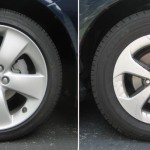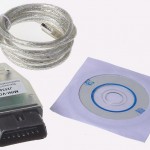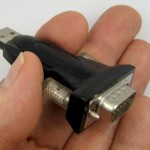Background:
My new Prius 5 (not V) came with 17″ wheels/tires – rather than the 15″ ones that came with lower trim levels. Great! (I thought.) Larger tire diameter will translate to smoother ride! Well, No. The wheels are larger, but they have skinny/low aspect ratio tires for an overall near-identical diameter. (P195/65 R15 vs P215/45 R17)
Some would say the skinny tires look cooler, but I don’t care at all. Some would point out better handling with the shorter, stiffer sidewalls. Look, I’m never going to push this family sedan hard enough to detect any difference. But all agree the ride is significantly harsher, and (my wife and) I really don’t like that.
 I posted on Craigslist for a trade for stock 15″ wheels/tires. Eduardo showed up a few days later, parked his Prius next to mine, and in less than half an hour we’d swapped all 4 wheels, shook hands, and he was off. His tires had a few thousand miles, so he gave me $60 for the difference. We were both happy with the trade. (I was even clever enough to verify that his wheels had TPM sensors.) My wife and I agreed the ride was much nicer with the new old tires. Mileage is alleged to be a little better with the 15 inchers. Great!
I posted on Craigslist for a trade for stock 15″ wheels/tires. Eduardo showed up a few days later, parked his Prius next to mine, and in less than half an hour we’d swapped all 4 wheels, shook hands, and he was off. His tires had a few thousand miles, so he gave me $60 for the difference. We were both happy with the trade. (I was even clever enough to verify that his wheels had TPM sensors.) My wife and I agreed the ride was much nicer with the new old tires. Mileage is alleged to be a little better with the 15 inchers. Great!
And then, of course, both our TPMS warning lights came on, as our ECUs no longer saw the TPMS IDs they expected. He paid $20 at a tire shop to have his new TPMS registered, but I wasn’t quick enough to ask him to have them read the old TPMS IDs from his ECU. I’ve heard Toyota typically charges ~$100 to read and reset the TPMS, so I thought 20 bucks at a tire place wasn’t too bad.
I had a cheapie ($8?) ELM327  Bluetooth OBD2 adapter that would talk to the car, but wouldn’t talk to the ECU in charge of tire pressure.
Bluetooth OBD2 adapter that would talk to the car, but wouldn’t talk to the ECU in charge of tire pressure.  For that you need a much fancier adapter/cable and fancier software. This goes for between $22 and $1500. I chose the $22 version (with free shipping from China!) OK, for this price, it’s cheap clone hardware and ripped, cracked software. If I were using this for business in a repair shop, I’d buy the real thing. But I’m not.
For that you need a much fancier adapter/cable and fancier software. This goes for between $22 and $1500. I chose the $22 version (with free shipping from China!) OK, for this price, it’s cheap clone hardware and ripped, cracked software. If I were using this for business in a repair shop, I’d buy the real thing. But I’m not.
Fun with FTDI
The cable came with a driver (on an unlabelled writable mini-CD). The driver wouldn’t install. I even wrote to the Ebay vendor and asked for help. But soon the light came on: I  remembered reading something about FTDI pushing out a driver that bricked counterfeit USB-serial chips. I dug deeper and found the VID:PID of the MVCI cable was 0403:0000 instead of the expected 0403:6061 for the FTDI chip it pretended to be. (An old USB serial adapter with a real FTDI chip was invaluable for checking PIDs, driver versions, etc.) Sure enough, both the Win8.1 tablet I planned to use in the car with the cable and my main Win7 desktop were running the dreaded 2.12.00 FTDI driver. And with that PID, even an old XP machine with an old driver wouldn’t recognize the cable. (I did write back to the Ebay vendor and told him that the problem was with counterfeit FTDI chips. Not blaming him for that – I knew what I might be getting into – but so he might help other customers with the same problem.)
remembered reading something about FTDI pushing out a driver that bricked counterfeit USB-serial chips. I dug deeper and found the VID:PID of the MVCI cable was 0403:0000 instead of the expected 0403:6061 for the FTDI chip it pretended to be. (An old USB serial adapter with a real FTDI chip was invaluable for checking PIDs, driver versions, etc.) Sure enough, both the Win8.1 tablet I planned to use in the car with the cable and my main Win7 desktop were running the dreaded 2.12.00 FTDI driver. And with that PID, even an old XP machine with an old driver wouldn’t recognize the cable. (I did write back to the Ebay vendor and told him that the problem was with counterfeit FTDI chips. Not blaming him for that – I knew what I might be getting into – but so he might help other customers with the same problem.)
After reading up on the situation – including a LOT of (justified) railing against FTDI (and Microsoft, for pushing the nasty driver out thru no-longer-well-trusted Windows Update) – I learned the damage was a ‘soft brick’ – just the PID rewritten to the invalid 0000 that made Windows not even look for a driver for it. I tried the PID writer FTDI has on their web site (there are legit reasons to change the PID), but could never make it work. Fortunately, I did get the ft232r_prog utility running on a Linux box, and rewrote the PID to 6061. Of course plugging the cable into either the tablet or the desktop immediately broke it again. But fixing again was trivial.
The 2.10 driver (freely available in the ‘No longer supported’ section on the drivers page of the FTDI site) was deemed safe, and I downloaded and installed it. I managed to uninstall the 2.12 driver, and removed it from %Windir%\System32\DriverStore\FileRepository (after some sleuthing involving file dates. I think from the dates I even figured which Microsoft KB update contained the driver, though I’ve lost that info.) There are actually 2 drivers: ftdibus.inf… and ftdiport.inf… .By going thru an ‘update driver’ dance including “Browse my computer for driver software” and “Let me pick from a list…”, I was finally able to convince both the tablet and the desktop to run 2.10. When I plugged in the MVCI cable, it worked!
It looks like the mini-CD had version 9.00 of TIS/Techstream software, so the 9.30 I’m running must have been downloaded from somewhere. It’s not hard to find (though I’m sure malware-infected versions abound). There seems to be a TISKEY.exe file that somehow enables the pirated software. While various sets of instructions say to choose the Europe locale, mine seems to be happy with North America.
TPMS IDs
OK, I had a cable that worked, drivers that didn’t brick it, and fairly current Techstream that could talk to the car. Unfortunately, Techstream would only register user-provided TPMS IDs, but not read and report the IDs it saw. The IDs are written on each TPMS – but on the body that lives inside the tire. Not helpful here.
The devices to trigger/awaken the TPMS and read its ID were $150 or more. I could justify the cost of the cheap Techstream/OBD2 stuff, as it has lots of potential uses, but the single purpose TPMS reader wasn’t worth it. A call to my local Discount Tire (I’ve been quite happy with them) revealed that they would reset the TPMS for free! The service rep said to just pull into the tire check station in front of the last bay. No paperwork – just ask them for a TPMS reset. Great!
I pulled in but the tech could only get the front 2 IDs, possibly because the car sat and the sensors went to sleep, or (more likely) because he held the reader near the wheel instead of the tire, so the 125 KHz wakeup signal was blocked by the rim. After failing on the rear 2, he couldn’t even read the front ones again. He was frustrated and mystified, and I said thanks for trying and left. A second visit a week later (with the car freshly moving as I pulled up) got all 4 IDs with no problem (front 2 matched first reading), probably using the same reader (but not the same guy).
Success!
With IDs in hand, I fired up Techstream, navigated to the TPMS section and its Utility to register new IDs, and in only 2 tries, got all 4 tires registered. I did a TPMS recalibration by holding the button hidden under the steering column for 3 flashes of the TPMS light, and went for a test drive. The light stayed out, though I’ve heard it can take 20 minutes or more for it to come on. (Update weeks later: The light has not come on since.)
 After I got back I fired up Techstream again, went to the TPMS Data List page, and saw not only the IDs, but tire pressure and temperature data from each tire. It must really be working! The pressures after the drive were ~34 PSI, and the temps ~92F. The capture on the right was taken later, after the tires cooled back down.
After I got back I fired up Techstream again, went to the TPMS Data List page, and saw not only the IDs, but tire pressure and temperature data from each tire. It must really be working! The pressures after the drive were ~34 PSI, and the temps ~92F. The capture on the right was taken later, after the tires cooled back down.
I need to do one more round of setting pressures precisely but maybe 3PSI over recommended, then recalibrating. That will bring the low warning threshold up by 3PSI, so it should give earlier warning. I’ll back the tires down to standard pressure after the calibration. Then I’ll be all done!

Thanks for that post. I did not realize the tire pressure monitors were that complicated. Just another, actually four, more things to break on a new car.
Nice post. 🙂 small addition: there is a workaround for the readout of the tires. RTL283x (~20$, check details here: https://osmocom.org/projects/rtl-sdr/wiki) + rtl_433 (https://github.com/merbanan/rtl_433). Tires sends signal every 90 secs. you can release some pressure to identify each tire. Tested – working with the default antenna which comes with the dongle.
Thanks, Jan. Sounds like a useful tool!